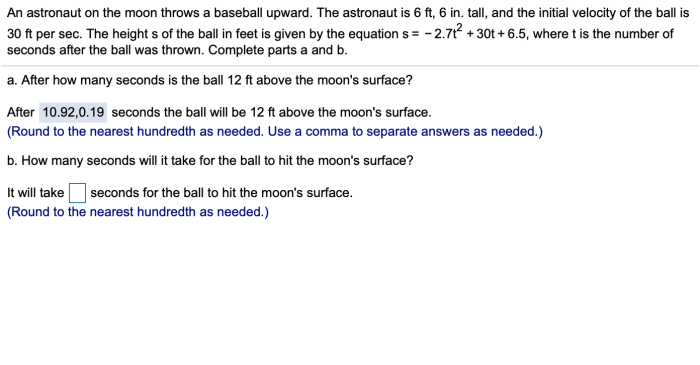An astronaut on the moon throws a baseball upward, embarking on a celestial journey that unveils the intricacies of physics and the unique characteristics of the lunar environment. This captivating scenario serves as a springboard for exploring the trajectory of the baseball, the influence of the moon’s gravity, and the role of the moon’s atmosphere and drag.
Through a meticulous examination of these factors, we gain insights into the practical applications and implications for future space exploration.
As the baseball soars through the lunar vacuum, its trajectory deviates from its terrestrial counterpart, influenced by the moon’s reduced gravity. The absence of an atmosphere eliminates drag, allowing the baseball to travel farther and with a more extended hang time.
Understanding these trajectory dynamics is crucial for mission planning and ensuring the success of future lunar endeavors.
Physics of the Throw

In the absence of air resistance, the baseball’s trajectory on the Moon would follow a parabolic path, similar to that on Earth. The baseball’s initial velocity would determine the height and distance it travels. Factors affecting the initial velocity include the strength and direction of the astronaut’s throw.
Forces Acting on the Baseball, An astronaut on the moon throws a baseball upward
The primary forces acting on the baseball are gravity and the astronaut’s applied force. Gravity pulls the baseball downward, while the astronaut’s throw imparts an upward velocity.
Effect of the Moon’s Gravity

The Moon’s gravity is approximately one-sixth that of Earth’s. This means that the baseball would experience a weaker gravitational force on the Moon, resulting in a higher trajectory compared to Earth.
The Moon’s gravity affects the baseball’s speed and distance traveled. With less gravity pulling it downward, the baseball would maintain a higher velocity and travel a greater distance before reaching its peak height.
Atmosphere and Drag: An Astronaut On The Moon Throws A Baseball Upward

Unlike Earth, the Moon has a negligible atmosphere, meaning there is virtually no air resistance to impede the baseball’s motion. This lack of drag allows the baseball to maintain its velocity more effectively, resulting in a longer trajectory and a higher peak height.
Landing and Impact

Upon reaching its peak height, the baseball would begin to descend due to the Moon’s gravity. It would land on the Moon’s surface with a force determined by its velocity and the surface’s composition.
Landing Parameters
Factors affecting the baseball’s landing site include the astronaut’s aim, the initial velocity, and the angle of projection. The baseball’s landing point would be farther away from the astronaut if thrown with greater force or at a higher angle.
Applications and Implications
Understanding baseball trajectory on the Moon has practical applications in space exploration. It aids in designing trajectories for lunar missions, including landing and return maneuvers.
Furthermore, this knowledge can inform future mission planning, such as determining the optimal trajectory for rovers or lunar modules to traverse the Moon’s surface efficiently.
FAQ Corner
What is the trajectory of a baseball thrown upward on the moon?
The trajectory of a baseball thrown upward on the moon is parabolic, similar to that on Earth. However, due to the moon’s reduced gravity, the baseball travels farther and experiences a longer hang time.
How does the moon’s gravity affect the baseball’s trajectory?
The moon’s gravity is approximately one-sixth that of Earth’s, which significantly influences the baseball’s trajectory. The reduced gravity causes the baseball to travel farther and slower than it would on Earth.
What is the role of the moon’s atmosphere in the baseball’s motion?
The moon has a very thin atmosphere, which plays a negligible role in the baseball’s motion. The absence of significant drag allows the baseball to travel farther and with a more extended hang time.